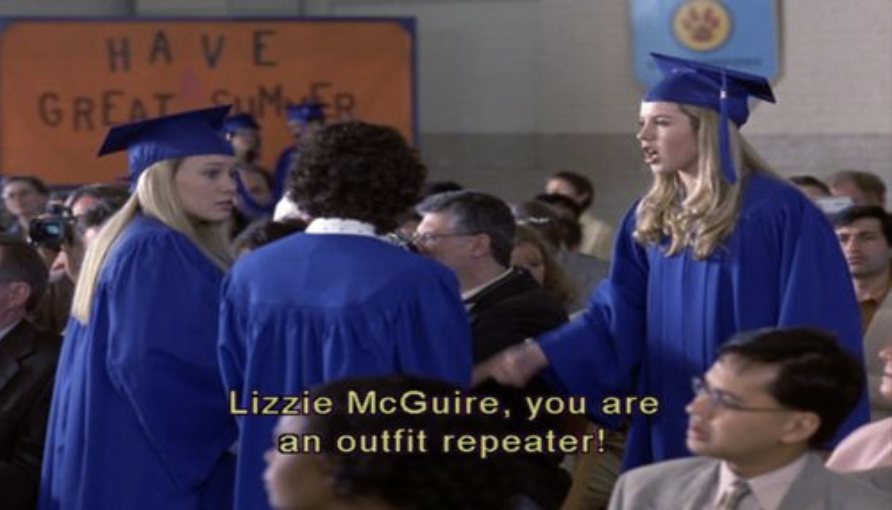Wear what you already have – spend as much time as you would shopping in your own closet re-discovering items you have and coming up with new outfit ideas. Consuming less does not have to equal minimalism. If you have clothes from fast fashion brands, getting rid of them and buying new clothes from sustainable brands is not the answer – at least, not all at once. You can definitely do this over time as pieces wear out, but wear the clothes you already have! I’m literally typing this while wearing a sweatshirt from Primark, a major fast fashion brand, but it’s a beautiful dark green velvet crew neck that I bought it years ago and loooove it so I’m going to wear the heck out of it until I can’t anymore.
Not into coming up with new outfit ideas? Spend as much time as you would shopping doing something else and be a proud outfit repeater!
Rent or borrow clothes when you don’t need to keep them, like for a special occasion.
Make informed choices when you are buying new when you need to. Do your research to find out if a brand is ethical. Kate Hall recommends waiting at least 1 month to buy any piece of clothing – this allows you time to do that research and is also a good way to avoid fast fashion that would be gone in a flash anyways.
- Activewear is tough, since it needs certain features to perform its function. Synthetic fibers tend to perform better, although this is something that could be addressed through natural fiber innovation. Some brands use recycled synthetic fibers (e.g. turn plastic water bottles into leggings, like Girlfriend Collective) instead of virgin fibers, which is better than nothing. These garments, however, are still releasing tiny bits of plastic into the water when they are washed, so it’s not a permanent solution. Opt for tools like the Cora Ball or the Guppyfriend washing bag when washing synthetic clothes, so these microplastics can be captured instead of going into the wastewater stream. I personally haven’t used either yet, but am trying to figure out which would be best for me. I’ve heard positive reviews of the Cora Ball from a reader! I also think there are pros to using the Guppyfriend washing bag, depending on your circumstances.
Buy secondhand instead of new when possible – shop at consignment stores, thrift shops, or ThredUp instead of going to the mall or shopping online. Attend clothing swaps or organize your own with friends or family members if you want to give your wardrobe a refresh. *Note that this doesn’t completely eliminate the overconsumption of clothing. You still also need to focus only on intentional purchases for a truly sustainable wardrobe. If you’re used to shopping every day, limit it to weekends only. If you shop once per week, try once per month. If you only shop once in a while, maybe consider a Buy Nothing challenge (see below).
Have a piece you love, but you rarely wear it since it doesn’t fit just right? Maybe you’ve experienced weight fluctuations and you need something taken in or out, which is also a major consideration of a long-term wardrobe. Consider finding a local tailor to adjust these pieces to suit you rather than getting rid of them. It’s an investment, but you might find it worth it to invest in a few higher quality pieces than stuff your drawers with a bunch of of flimsy, cheap garments that won’t last.
Learn to mend the small stuff! There are plenty of videos online that explain how to do simple repairs that can bring your beloved garments back to life. Even better – if you have a friend or family member that’s handy with a needle and thread, ask them to show you how!
Care properly for your pieces. A big mental change is washing them only when they’re dirty, not necessarily after every use, which I think is what most people tend to do. You can always opt to spot wash when needed and it’s best to air dry and not use the dryer when possible – both for the longevity of your clothes and to save electricity. This is coming from someone who tosses practically everything in the dryer, always. Working on it!
*If* your space is feeling cluttered, downsizing what you no longer wear so you can appreciate the pieces you really love might be the move for you. You could consign, donate clean pieces in wearable condition (no mends needed!) to your local thrift shop, send them into ThredUp, or try listing on FreeCycle or in a Facebook Buy Nothing group.
If a garment has come to the end of its useable life, it still doesn’t belong in the trash. You can opt for textile recycling – check out the programs in available in your area. Boston and Cambridge use HELPSY, which is a company that accepts textiles in all conditions and sorts them accordingly, then sends them to the appropriate partner for processing. Some vets and animal shelters accept old textiles and I’ve even heard some mechanics will take them for rags. If you need rags around your own home, hang onto a few yourself!

